About 90 developed campsites sit on the North Rim, but only a fraction are available without months of advance reservations. You’ll find cooler temps, towering pines, and quieter trails than the South Rim, yet planning is nonnegotiable for both rim sites and sought-after backcountry slots. Keep your water, permit, and weather contingencies top of mind, and you’ll be ready to learn the practical tips that make a North Rim trip smooth and memorable.
Key Takeaways for Camping the North Rim
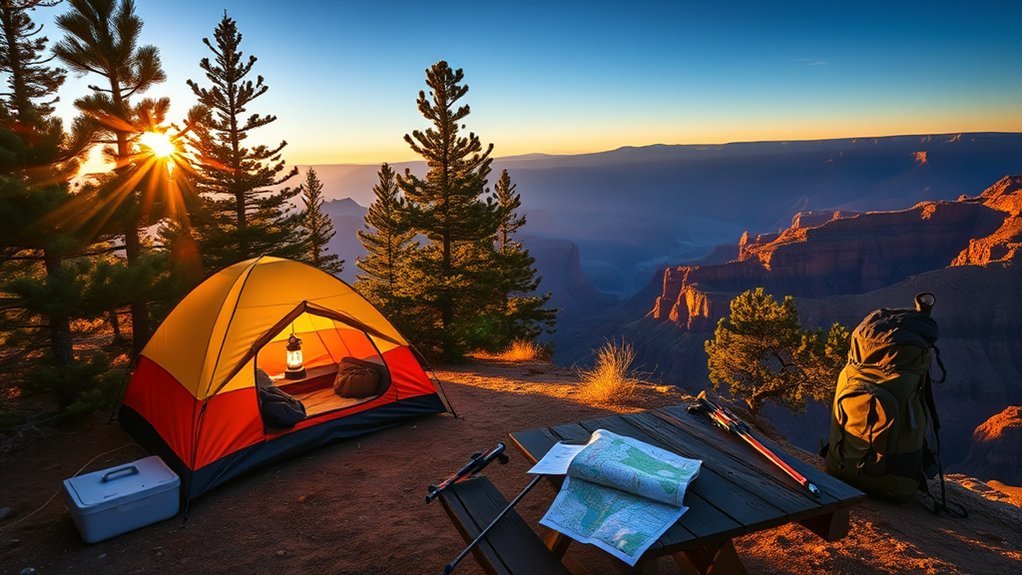
Wondering what makes camping the North Rim special? You’ll find the North Rim Campground inside Grand Canyon National Park, open seasonally May 15–October 15 with 90 sites that include picnic tables and fire rings but no hookups. Plan ahead: reservations through Recreation.gov go live six months out and sites fill fast. Expect cooler temperatures and more natural shade at roughly 8,000 feet, so pack layers and enjoy a quieter, more secluded experience than the busier South Rim. If you want wilder nights, backcountry permits are required for spots like Tuweep Campground or Indian Hollow, which offer rustic solitude without amenities. Overall, book early, bring appropriate gear, and respect permit rules for a smooth trip.
Who Should Camp at the North Rim and When to Go
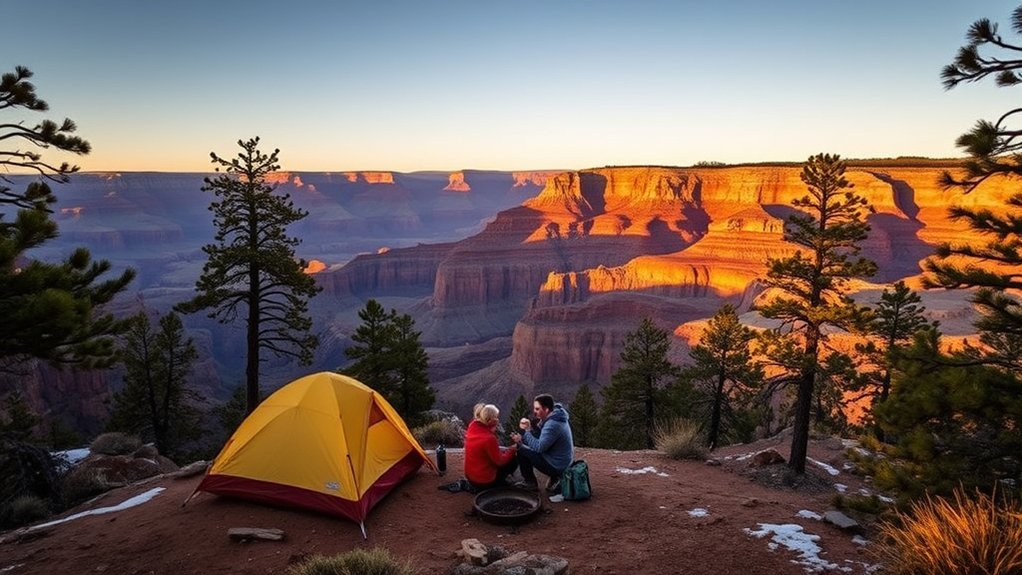
If you prefer quieter trails, cooler summer days, and a more rustic camping rhythm, the North Rim is for you. You should go if you want a quieter experience away from crowds at Grand Canyon National Park, shaded by ponderosa pines and aspens and enjoying a cooler climate around 8,000 feet. Remember the camping season runs May 15–October 15; winter roads close and heavy snowfall limits access.
- You’re after solitude: choose the North Rim for fewer visitors and a true backcountry feel.
- You plan ahead: the campground has 90 sites and reservations are essential—book months early.
- You accept limited amenities: expect basic services, no hookups, and a more primitive stay.
North Rim Developed Campgrounds and Amenities
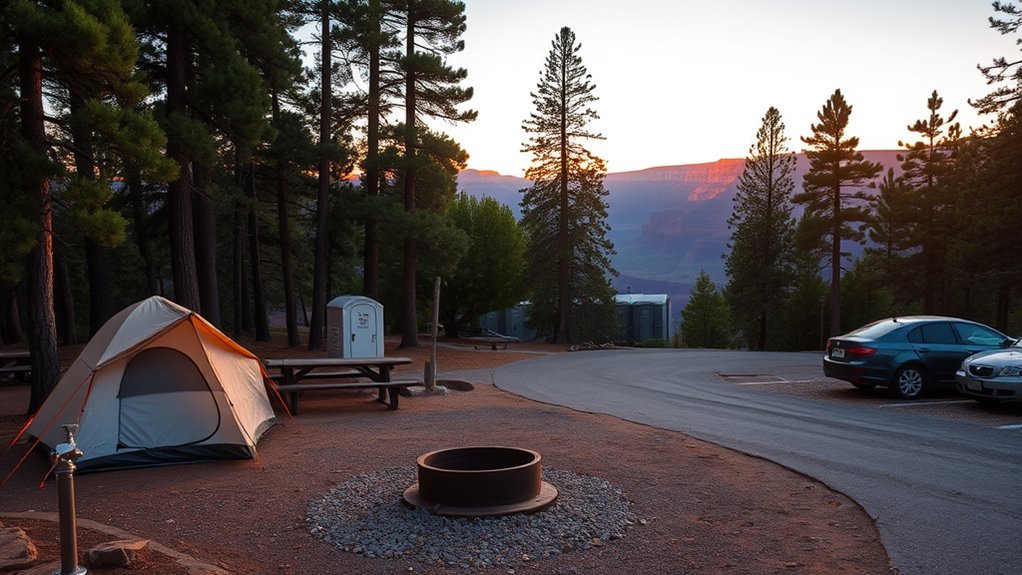
Although the North Rim feels remote, you’ll find a handful of developed camping options that keep your stay comfortable without spoiling the backcountry vibe. The primary site is North Rim Campground: 90 sites (78 mixed-use sites and 12 tent-only sites), most perched along the rim. Amenities are basic but useful—picnic tables, fire rings, composting toilets—so bring water and be self-sufficient; there are no hookups. The campground runs seasonally May 15–Oct 15 and requires reservations via Recreation.gov. For a wilder experience, Tuweep Campground offers 10 primitive sites deep in the Tuweep area and requires advance backcountry permits. Indian Hollow Campground gives three first-come, first-served sites with limited facilities—a picnic table and fire ring but no potable water.
Top Backcountry Campgrounds Below the Rim
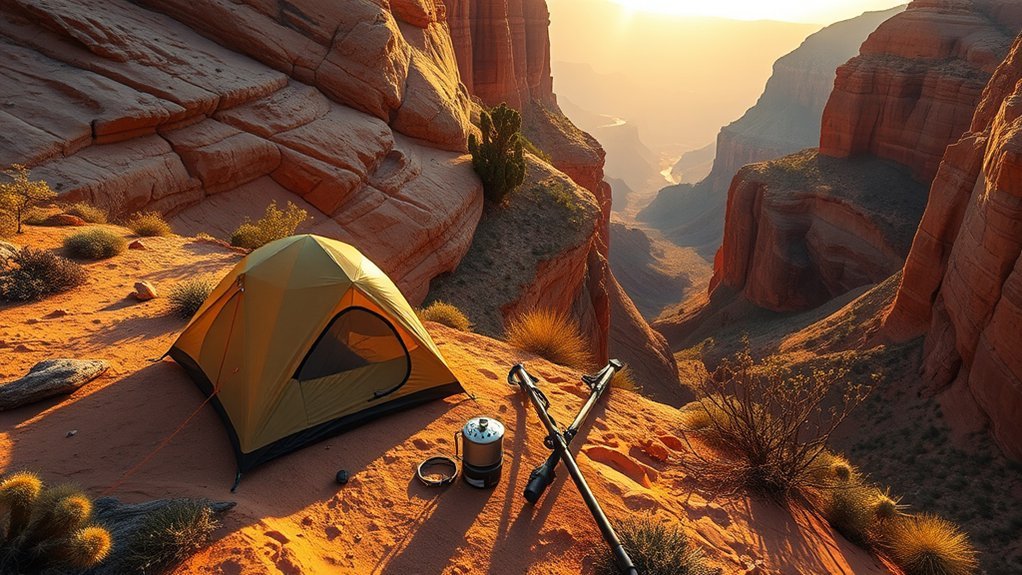
Below the rim you’ll find three top backcountry campgrounds—Bright Angel, Indian Garden, and Cottonwood—each requiring a Backcountry Office permit for overnight stays. Bright Angel and Indian Garden sit along the Bright Angel Trail with restrooms, treated water, and shaded sites, while Cottonwood on the North Kaibab Trail offers seasonal potable water and access to day hikes like Roaring Springs and Ribbon Falls. Remember permits limit you to two consecutive nights per campground and the application process can be competitive, so plan up to four months ahead.
Bright Angel Campground
A welcome oasis on the canyon floor, Bright Angel Campground sits along the Bright Angel Trail 6.8 miles from the South Rim and is the only developed campground below rim level—perfect if you want easy access to water, restrooms, and frequent ranger help. You’ll find 31 small group sites plus two larger group sites, each with a table and food storage boxes to meet food storage rules. For overnight camping you must obtain a Backcountry Office permit ($10 plus $5 per person/night); reservations are competitive, so apply up to four months ahead. Amenities include treated drinking water, restrooms, and regular ranger staffing. Practical for hikers, it connects to popular hiking trails and suits small parties seeking reliable services.
- Plan permits early.
- Pack light; use storage boxes.
- Expect ranger contact.
Cottonwood & Indian Garden
If you’re heading below the rims for a true backcountry experience, Cottonwood and Indian Garden are the two top camps that balance convenience with solitude. You’ll need a Backcountry Office permit for overnight camping at both sites and must respect the maximum stay limit of two consecutive nights. Cottonwood Campground sits 6.8 miles down the North Kaibab Trail, offering seasonal potable water mid‑May to mid‑October, toilets, and access to hiking trails like Roaring Springs, Ribbon Falls, and Manzanita Canyon for a quieter, more remote feel. Indian Garden Campground, 4.6 miles down the Bright Angel Trail, provides treated drinking water, restrooms, food storage canisters, and lush vegetation that makes it a favored shaded rest stop. Plan water, timing, and permits carefully.
How to Apply for Backcountry Permits and the Waiting List
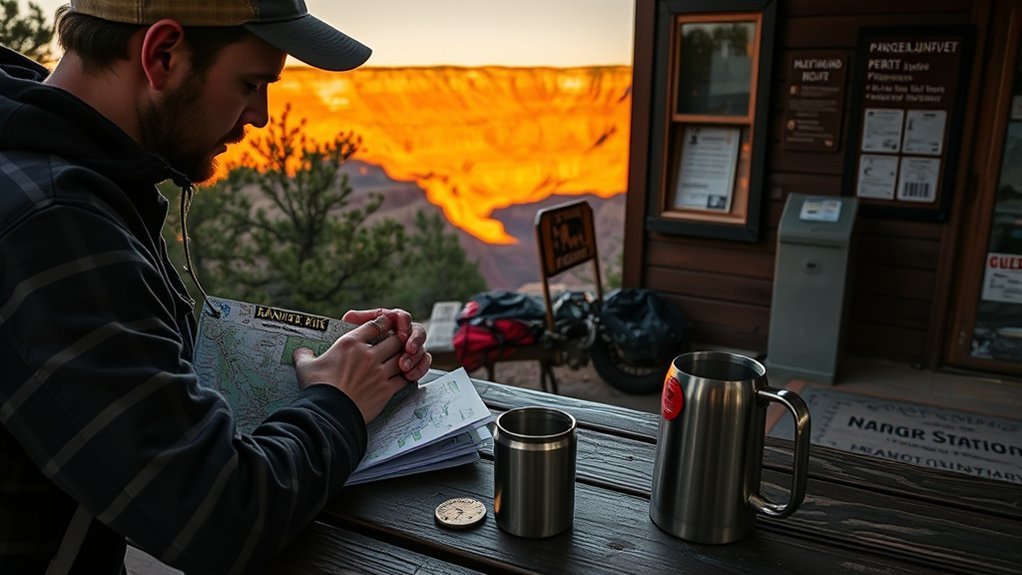
Because overnight trips below the rim require careful planning, you’ll need a Backcountry Permit before you camp anywhere in the canyon (including undeveloped rim sites). You should apply up to four months ahead because permits are limited; the process is precise and the fee is $10 per permit plus $5 per person per night. Permit requests are accepted in-person at Backcountry Information Centers (North Rim seasonally, South Rim year-round), or by fax or mail — not by phone or email.
- Visit the North Rim Backcountry Office (mid-May–mid-October) or South Rim year-round to submit requests in-person.
- Mail or fax applications if you can’t be there; include desired routes and dates.
- If you’re last-minute, add your name to the in-person waiting list for possible same-day permits.
Practical Planning: Gear, Water, and Safety Considerations
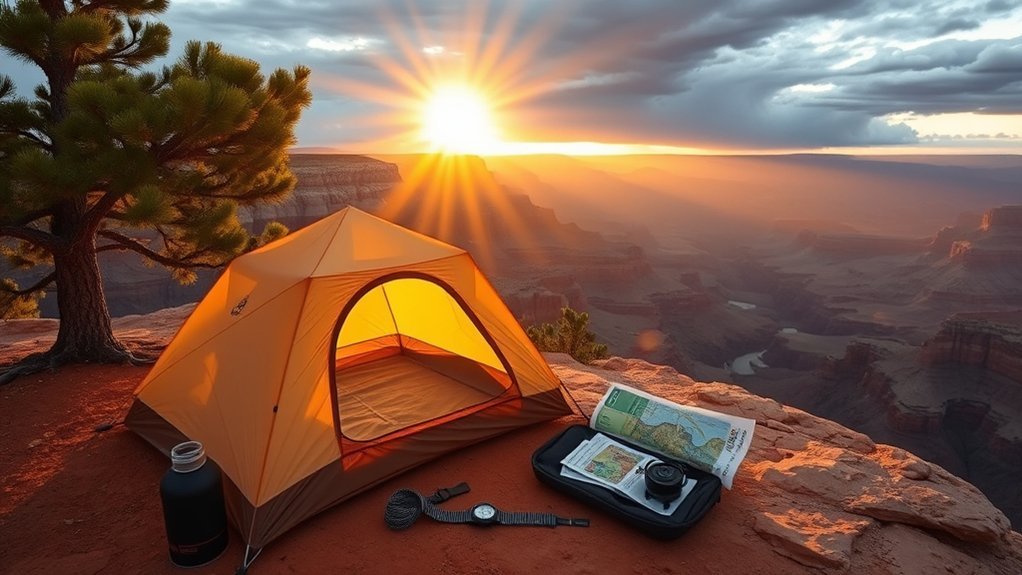
Count on packing smart: bring at least 2 liters of water per person per day (more in summer), a reliable map and compass, a well-stocked first-aid kit, layered clothing for sudden temperature swings at the North Rim’s ~8,000 ft elevation, and gear suited for leaving no trace and staying safe below the rim—remember that every overnight stay requires a backcountry permit. You’ll prioritize water and safety: carry purification, check forecasts for temperatures shifts, and pack emergency shelter. Practice Leave No Trace; respect fragile canyon ecosystems. Below is a simple table to stir your sense of responsibility and awe.
| Essential | Feeling | Action |
|---|---|---|
| Water | Relief | Refill plan |
| Map/Compass | Confidence | Route check |
| First-aid | Calm | Inspect kit |
| Layers | Comfort | Adjust temps |
| Permit | Respect | Reserve early |
Access, Roads, and Nearby Outside-Park Camping Options
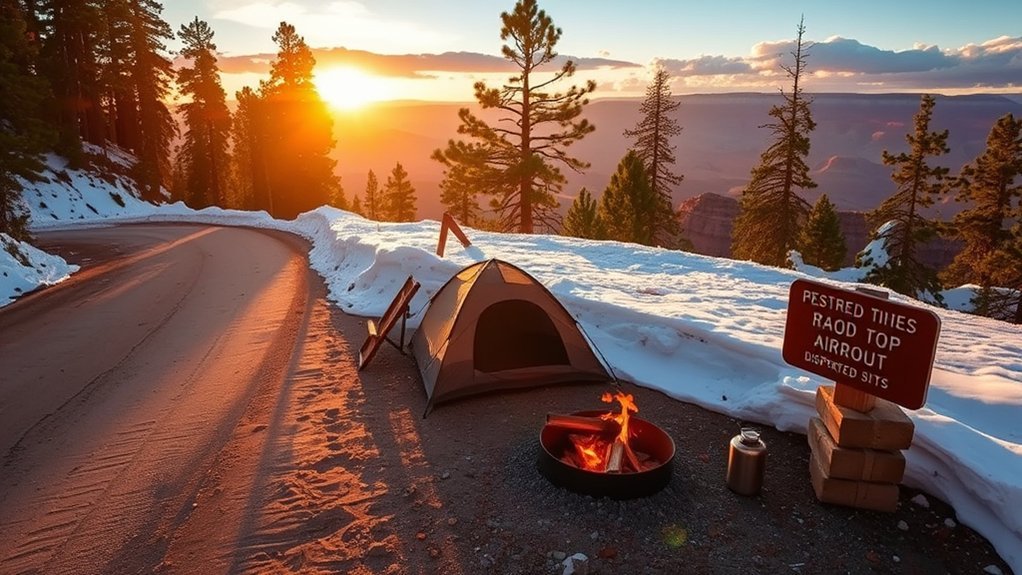
While the North Rim’s seasonal access (mid‑May to mid‑October) keeps crowds down, it also means you’ll plan your trip around a narrow window and longer drives—expect about two hours from Page via Jacob Lake and quieter, less-maintained roads than the South Rim. You’ll find remoteness rewarding: pullouts, sweeping views, and the creak of pines. For outside-park camping options and practical tips, consider nearby choices and forest dispersed sites.
- Kaibab Camper Village — full RV sites about 45 miles from the North Rim entrance; handy if you need hookups.
- DeMotte Campground — 16 miles north for a rustic, off-grid feel.
- Kaibab National Forest dispersed camping — non-reservable spots (Saddle Mt. Overlook); arrive early for best sites.
Plan for seasonal limits, rough roads, and extra driving time to enjoy the Grand Canyon’s quieter side.
Rules, Stay Limits, Fees, and Group Regulations
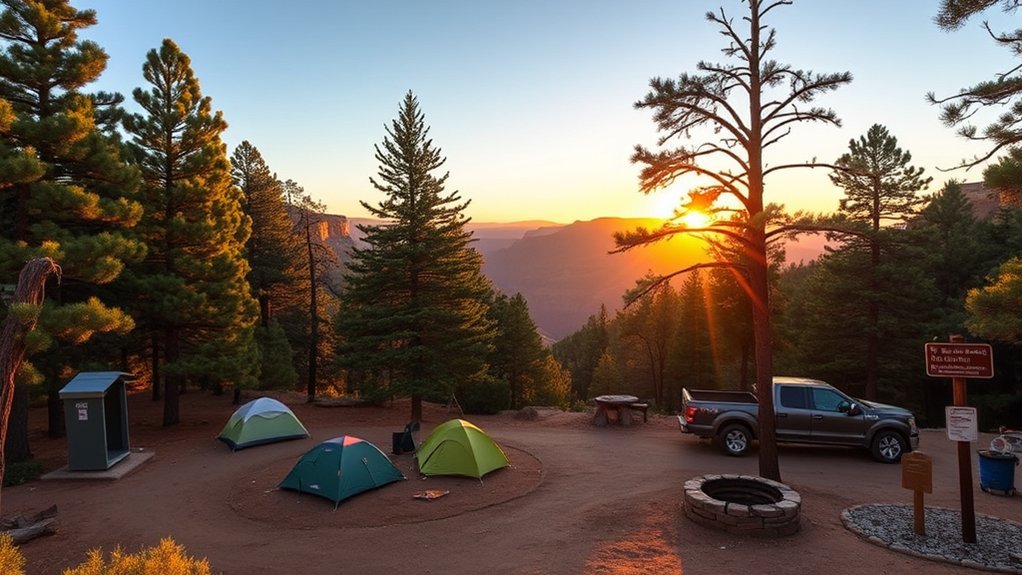
If you’re planning to camp on the North Rim, know that permits and rules aren’t optional: every overnight stay—backcountry or developed—requires a Backcountry Office permit, reservations are mandatory (you can book up to six months ahead), and stay limits, fees, and group sizes are strictly enforced to protect the park’s fragile environment.
| Item | Rule |
|---|---|
| Permit | Required for all overnight camping |
| Stay limits | 2 consecutive nights at backcountry sites |
| Fees | $10 permit + $5/person/night backcountry |
| Group occupancy | Typically max 6 people per site |
You’ll follow group regulations on vehicles and occupancy, pay applicable fees, and respect developed campgrounds’ different rates. Plan within reservations and stay limits to guarantee a legal, low-impact experience.
Tips for Booking, Contingency Plans, and Responsible Camping
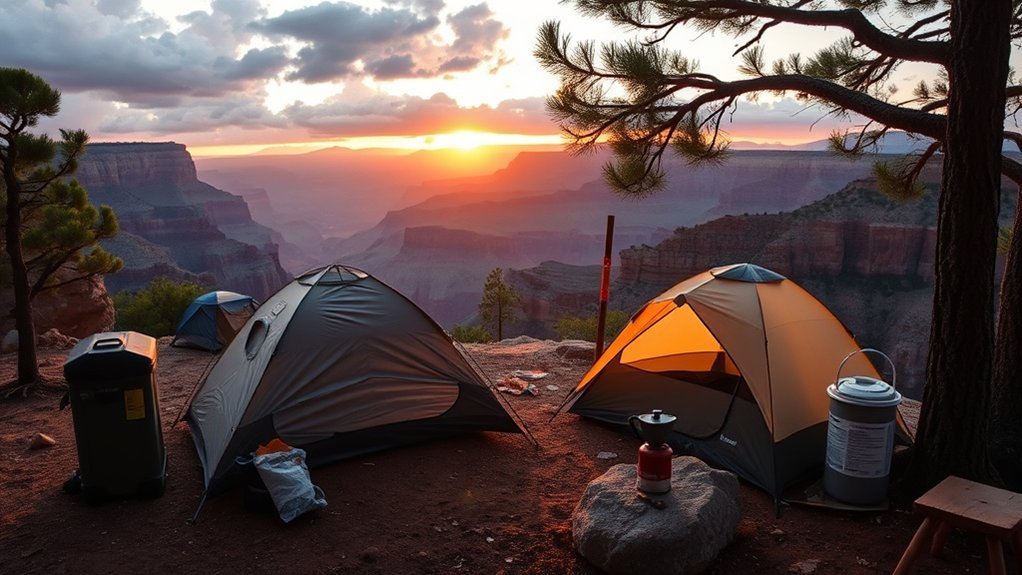
Because spots fill fast on the North Rim, book your campground reservation through Recreation.gov as soon as your dates open (up to six months ahead) and have backup plans like Kaibab Camper Village or De Motte Campground ready in case the park is full or seasonal closures affect facilities. Plan for peak season (May 15–Oct 15), know surrounding forest options, and expect limited amenities.
- Reserve early: use Recreation.gov, target weekdays, and monitor cancellations.
- Prepare contingency plans: scout Kaibab Camper Village, De Motte, or dispersed camping; pack tents, stove, and extra potable water.
- Practice responsible camping: follow Leave No Trace, pack out waste, minimize campfire impacts, and respect wildlife.
These steps maximize camping opportunities while protecting the North Rim for future visitors.
Frequently Asked Questions
What Are the Rules for North Rim Campsites?
You must follow campsite regulations: stick to designated sites, respect group size limits and seasonal closures, observe quiet hours, follow fire restrictions, secure food for wildlife encounters, practice campsite etiquette, use proper waste disposal, and know water access.
Is It Better to Camp on the North or South Rim of the Grand Canyon?
You’ll choose like a traveler picking two paths: North Rim advantages offer solitude, cooler weather conditions, unique hiking opportunities, wildlife encounters, and Scenic views; South Rim advantages give Accessibility differences, campground amenities, Photography spots, and varied visitor experiences.
How to Get Backcountry Camping Permit in Grand Canyon?
You get a backcountry camping permit by submitting a permit application in person, fax, or mail; plan for backcountry safety, follow wilderness regulations, limit group size, pack proper camping gear, study trail maps, water sources, cooking tips, fire restrictions, wildlife encounters.
Where to Camp Near Grand Canyon North Rim?
Camp at the North Rim Campground, Tuweep, Indian Hollow, Kaibab Camper Village, or dispersed Kaibab Forest — you’ll choose camping options, follow campfire regulations, enjoy scenic views, wildlife encounters, hiking trails, campsite amenities, weather conditions, stargazing opportunities, photography spots, local flora.
Conclusion
You’ll leave the North Rim with clearer plans and steadier steps, ready to trade crowded rims for quiet backcountry nights. Pack smart, get permits early, and respect rules so the canyon stays wild for everyone. Treat water and weather like your compass, and have backup options if roads or sites close. Think of your trip as a carefully charted map—follow it, stay flexible, and the canyon will reward you with unforgettable, responsibly earned views.

